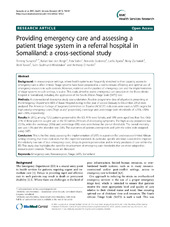| dc.description.abstract | Background: In resource-poor settings, where health systems are frequently stretched to their capacity, access to emergency care is often limited. Triage systems have been proposed as a tool to ensure efficiency and optimal use of emergency resources in such contexts. However, evidence on the practice of emergency care and the implementation of triage systems in such settings, is scarce. This study aimed to assess emergency care provision in the Burao district hospital in Somaliland, including the application of the South African Triage Scale (SATS) tool. Methods: A cross-sectional descriptive study was undertaken. Routine programme data of all patients presenting at the Emergency Department (ED) of Burao Hospital during its first year of service (January to December 2012) were analysed. The American College of Surgeons Committee on Trauma (ACSCOT) indicators were used as SATS targets for high priority emergency cases (“high acuity” proportion), overtriage and undertriage (with thresholds of >25%, <50% and <10%, respectively). Results: In 2012, among 7212 patients presented to the ED, 41% were female, and 18% were aged less than five. Only 21% of these patients sought care at the ED within 24 hours of developing symptoms. The high acuity proportion was 22.3%, while the overtriage (40%) and undertriage (9%) rates were below the pre-set thresholds. The overall mortality rate was 1.3% and the abandon rate 2.0%. The outcomes of patients corresponds well with the color code assigned using SATS. Conclusion: This is the first study assessing the implementation of SATS in a post-conflict and resource-limited African setting showing that most indicators met the expected standards. In particular, specific attention is needed to improve the relatively low rate of true emergency cases, delays in patient presentation and in timely provision of care within the ED. This study also highlights the need for development of emergency care thresholds that are more adapted to resource-poor contexts. These issues are discussed. | en_US |

